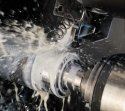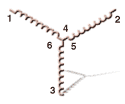Wye/Delta In Perspective
Two configurations of windings on a spindle motor can provide consistent torque and higher horsepower across a machine tool's speed range, but other features for improved performance are also important.
Share


Takumi USA
Featured Content
View More




"Wye/Delta" is often discussed when talking about spindle motors and spindle drives for machining centers. Unfortunately, these discussions do not often start with a very good definition of just what wye/delta is. It is time to clear up the waters. This article will show how wye/delta on a spindle motor can provide consistent torque and higher horsepower across a machine tool's speed range and also show how other features to improve performance can be just as important.
The goal of the spindle motor in any machine tool is to deliver power to the cutter—a rather straightforward concept. But to really understand how this works, a few definitions are in order. It is important to understand exactly what power is, and how it relates to torque and speed.
About Power
In the world of physics, power is defined as work done or energy transferred per unit of time. Torque is defined as something that produces rotation, or the moment of a force tending to cause rotation. Motor speed is defined as . . . well, motor speed. All three are closely related through the following equation: POWER equals TORQUE times SPEED, or P = FT-LB × rpm.
Following this equation, a machine that is generating torque but is not turning is providing no power. Similarly, a machine that is turning but generating no torque is providing no power. In fact, the power, or horsepower, supplied by a machine is found by multiplying the torque by the speed in revolutions per minute (rpm). If a machine were capable of providing its rated horsepower down to a very low speed, the torque would need to grow to fantastic values. Since any machine must inherently have a torque limit, the horsepower available at low speeds is limited. There are ways to overcome this limitation, as the box on page 96 shows.
Just about every machine tool built in the last 50 years has used an "induction" motor to turn the spindle. An induction motor is a very simple type of motor that contains non-rotating windings, no brushes, and a rugged one-piece rotor. These motors are, in fact, a very old design and were first used just before the end of the previous century. They are, however, still a very good choice for spindle motor power because of their simplicity, cost, and power for their size.
Induction motors usually are designed to run at a fixed speed and voltage which, for a simple drill press, would exactly match the frequency (60 Hz) and voltage (240 volts) available in a shop. The frequency of the voltage applied to an induction motor defines the speed at which it will turn. The typical motor turns at 1800 rpm when 60 Hz is applied. There is also a simple relationship between voltage and frequency if the motor is going to deliver its designed torque. This typically is 230 volts per 1800 rpm. If the motor is going to run at 900 rpm it really requires only 115 volts and if it is going to run at 3600 rpm it would require 460 volts.
The drives used to run induction motors can generate a variable frequency and voltage output, but they are not capable of raising the voltage on the motor above the line voltage going into the drive. The motor can supply the rated motor torque up to the speed where the voltage required by the motor matches the line voltage. This is usually called the motor "base speed." Thus, motor performance is normal below the base speed, and all of the rated torque of the motor is available. This speed range is called the "constant torque" range.
To run a motor above the base speed, something called "field weakening" must be used. This is where the rpm and frequency increase but the voltage stays limited at the line voltage. The torque available from the motor goes down as the speed goes above the base speed. Since rpm is increasing while the torque is decreasing, the power, or the product of these two, remains constant. The "constant power" range is usually between the motor base speed and about two-and-a-half times base speed. Above that speed, torque drops even faster than speed increases and the available power decreases.
All of the above conditions are true because the motor requires a higher and higher voltage as speed increases and this voltage is above what is available from the power company. It is possible to build a motor which requires less voltage; however, such a motor also requires more current (power is the product of voltage and current), and this increases the cost of the drive electronics.
An alternative to the above is to use a motor that has two different winding configurations: one for low speed, which is a high voltage, or Wye, winding; and one for high speed, which is a low voltage, or Delta, winding. The easiest way to change a motor winding is to go from the standard Wye winding, which is usually 230 volts at 2,000 rpm, to a Delta winding, which would then be 230 volts at 3,460 rpm. The advantage gained from this wye/delta change is always a factor of 1.73 because of the way that the windings of an induction motor are put together. Thus it can only increase the constant power range by 73 percent.
Figure 1 shows how the windings of a motor can be rearranged to make Wye or Delta. It is important to note that the Wye and Delta windings "are the same windings." It is only how these windings are connected together that makes them Wye or Delta. The method usually used to change windings is a pair of heavy-duty relays or "contactors."
The Transmission Counts Too
It is important to note that wye/delta switching can only extend a motor's speed range by a factor of 1.73, and it cannot extend the low speed range of a motor. If the constant power range is 2.5 times the base speed without winding change, the motor will have constant power from 2,000 to 5,000 rpm. If a wye/delta change is used, it will increase the constant power speed to 8600 rpm. This is not a huge amount, but it is usually enough improvement in performance to make it worth the effort. A typical transmission will extend the constant power range of a motor by a factor of four. Thus a wye/delta changeover can be considered a "low-cost" transmission.
Alternatives To Consider
Another way to get even more performance is to use wye/delta switching and a transmission. This will combine the increase in constant power range from the transmission and from the winding change to provide more than either of these by themselves. See Figure 2.
Gear selection is either done automatically by the control, based on the selected speed, or by an M-code. Gear changes are almost always done with the motor stopped, as there is no clutch or synchronizing mechanism in transmissions for machine tools. Obviously, the best system performance is obtained using a transmission along with a wye/delta switch. The wye/delta switch can increase performance at the high speed end, and a transmission can increase performance at the low speed end.
Yet another way yet to get even more performance than a wye/delta switch is to remain in the Delta winding. This reduces the complexity of the wiring to the motor but requires a drive with 73 percent more current capacity. This is better because the winding change reduces the voltage required by a factor of 1.73. This allows the motor to deliver its rated torque to a speed 73 percent higher, but increases the current requirement by a factor of 1.73. This means that you are not getting all of the performance possible out of the motor unless the drive can supply an additional 73 percent of current. Supplying this additional current is rarely provided for because it increases the cost of the electronics in the drive system of the machine tool.
Switching On The Fly
The method of selecting between Wye and Delta is also an important factor. Many systems use the wye/delta selection like a gear change where the users must pick a gear before even starting the spindle. There is a more powerful technique which is called switching "on-the-fly." With this method, the system starts out in the low-speed Wye winding and changes to the high speed Delta winding when the spindle speed reaches a point where performance would be improved.
Winding change on-the-fly requires a very carefully tuned motor and drive combination to ensure that there is a quick change and not a loss of power during the winding change. Very few machine builders today are using it for this reason.
Winding change on-the-fly is important mostly for lathes which are constantly making spindle rpm changes and which change the rpm while in a cut. The wide "constant power" range provided by the winding change is needed during a constant surface speed lathe cut which makes a large diameter change from beginning to end.
Vector Drives
Another term that is used frequently in the industry without much explanation is "vector drive." A vector drive is the latest technology available to run induction motors. Vector drives provide optimal motor performance over the widest speed range. They have three major advantages over older "variable frequency" drives. These are 1.) rated torque of motor available all the way down to zero speed, 2.) very accurate speed control, and 3.) no possibility of "stalling" the motor and not knowing it happened.
Vector drives have these advantages because they can control precisely the current running in each of the three "phases" of the motor wiring. This current generates a magnetic field whose vector direction and magnitude are modulated precisely to generate the required torque in the motor. The vector is controlled according to the rotation of the motor so vector drives require some device like an encoder connected to the motor to determine how fast the motor is rotating. The drive "knows" exactly what speed the motor is running with this encoder and can thus provide a very precise speed control all the way down to zero speed. This same function also allows the vector drive to avoid the problem of a stalled motor by always detecting and responding to the exact motor speed.
Vector spindle drives are in use in many machine tools today. They can dramatically improve system performance. Winding change is not always used with a vector drive but most of the manufacturers using winding change are also using vector drives.
Read Next
Registration Now Open for the Precision Machining Technology Show (PMTS) 2025
The precision machining industry’s premier event returns to Cleveland, OH, April 1-3.
Read MoreBuilding Out a Foundation for Student Machinists
Autodesk and Haas have teamed up to produce an introductory course for students that covers the basics of CAD, CAM and CNC while providing them with a portfolio part.
Read More5 Rules of Thumb for Buying CNC Machine Tools
Use these tips to carefully plan your machine tool purchases and to avoid regretting your decision later.
Read More






.png;maxWidth=150)













































